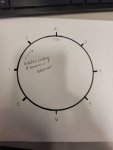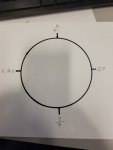I had 13G in mine, factory as far can be determined. Vehicle had 9000 miles in 2012 when I liberated it from Ft McCoy WI. Had starting issues last year, 3 were burned out and 2 lost the spades on replacing, none were swollen. The starting difficulty also presented with much shorter pre glow, indicating the voltage sense circuit was properly working. This cuts the solenoid when voltage is over 16.2 at the solenoid output terminal. This is the thin orange wire, it must be connected to the same terminal as the two large orange wires.
I replaced with Bosch Duratherms which I modified with a file from 1/4" to 3/16". None have swollen when pulled to do compression testing and leak down analysis on the weak cylinder, #5 leaks at around 300 PSI into the cooling jacket. Yes, I have air at that pressure from my air rifle hobby. Actually put the compressor on the intake manifold as the 4500 PSI hose is only 20" long. I pulled the Schraeder valve from the GP adapter which has a 8mm Foster male QD, compatible with the industry standard QD for pre charged pneumatic air rifles. Melding of my hobbies makes me happy.
For GP to swell, they need excessive temperature and oxygen inside the pressure sheath. The oxygen is from failing seal on the center terminal, a problem of aging. Most plugs are filled with zinc oxide powder which conducts heat and is an electrical insulator at these voltages. It prevents most air contact when new, age and thermal cycling causes it to pack and allow air contact with the elements. High temperature oxidation of the nickel-chromium resistance element is the cause of the swelling. If the seal on the center electrode fails and admits water, similar swelling is possible.
Would I recommend a 50k/5 year replacement interval? Certainly would help. But if you have a turbo, that is a bunch of work.



